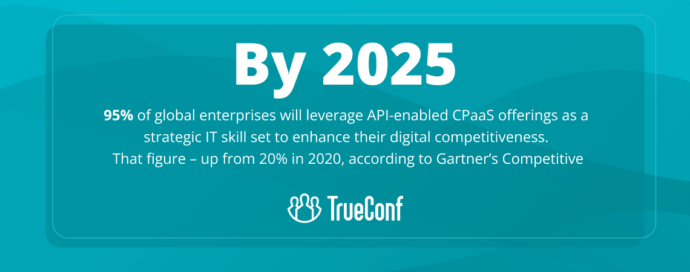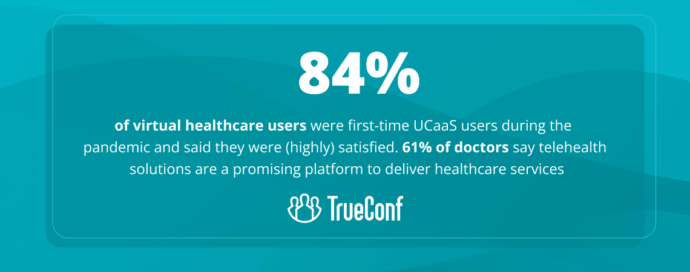CPaaS (Communication Platform as a Service)
CPaaS (Communication Platform as a Service) is a technology that enables customers to provide a complete software environment and tools for real-time communication with their clients or company employees. Using CPaaS, customers get access to:
- SDK and libraries for embedding the platform into their own applications
- API catalog
- Product Documentation
This cloud-based communication model is most popular in software development, sales and support. Due to the rapidly rising demand for video conferencing services (the growing number of employees working remotely and the increasing popularity of distance learning), CPaaS has significantly expanded its presence on the market. According to the Juniper Research study, the CPaaS market is expected to grow to $25 billion by 2025.
How does CPaaS work?
CPaaS providers offer a platform that enables businesses to develop and deploy custom communications applications. These applications can include features such as voice calling, messaging, and video conferencing. The CPaaS platform provides the necessary tools and resources to create and manage these applications, as well as the infrastructure to deploy them.
CPaaS works through software tools, standard application programming interfaces (APIs), code samples, and out-of-the-box applications.
The API acts as a connector between the two endpoints, allowing them to communicate with each other more effectively. Each API is a building block that adds a new set of functions to an existing application. For example, if you want to add VoIP calls to your application, you need to find the voice API.
So to use CPaaS, you need devices and/or software that knows how to interact with API endpoints.
As a part of CPaaS, the customer gets access to:
- SDK and libraries for embedding into their own applications
- API catalog
- Product documentation
- Customer support
To successfully implement CPaaS, it is important to carefully examine the examples of communication channels you plan to utilize.
What are the advantages of using CPaaS?
Customers usually choose a suitable platform from the list created by the service provider. The vendor is responsible for administration of the entire infrastructure, ensuring the platform availability and performance. Customers receive a ready-made solution to be integrated into their product.
Pricing also varies. The provider may charge for:
- actually used resources and capacities (e.g. active minutes, number of active subscribers, video/audio traffic, etc.)
- booking capacity guaranteed to be available to the customer.
As an example, let’s consider how CPaaS implementation can simplify providing technical support services. For instance, your customer would like to integrate communication tools (text chat, voice and video calls) into their business application.
With CPaaS, your customer doesn’t need to develop program logic on their own. Instead, your client only needs to add the necessary components to the application interface and integrate them with their provider’s communication platform infrastructure using libraries and APIs.

After that, users will be able to contact technical support directly from the application in any way they like. You can customize client request processing: for instance, a bot can answer simple and frequently asked questions, saving your company’s human resources.
With the help of smart call switching the system views the user’s information specified in the application and assigns an appropriate call agent to answer their request. For example, you can set up a special support service for VIP clients or organize the processing of all requests by region.
If you need to inform users about some event (e.g. picking up an order or asking for feedback), you can integrate a module that automatically sends notifications to users right into your application.
With CPaaS, your customers don’t need to administer their communication platform server, monitor infrastructure performance, deploy and upgrade the software. Moreover, there is no need to use several video conferencing systems or messengers at once, as all functions can be integrated into a single application.
|
Advantages of CPaaS |
Disadvantages of CPaaS |
|---|---|
|
Remote access to the communication platform for multiple users simultaneously accessible from anywhere in the world. |
The set of platforms and services available to the customer is limited by the capabilities of the vendor. |
|
The ability to easily opt out of services or switch to a more suitable platform within the same service provider. |
Complexities of software migration between service providers. Services available with one provider may not be available with another provider. |
|
The service provider processes all data, so there is no need to deploy a powerful and expensive infrastructure on the customer’s premises. |
Possible issues with the infrastructure availability, e.g. failure of data centres can lead to significant downtime. |
|
The service provider ensures the availability and security of the cloud environment. |
|
CPaaS vs. UCaaS
CPaaS and UCaaS are popular communication platforms, each with its own characteristics. The key difference between UCaaS and CPaaS is that UCaaS offers a complete suite of unified communications tools, while CPaaS is a platform for developers to build communications applications.
UCaaS technology combines group communication, video conferencing, self hosted chat, and cloud calling into a single application, allowing customers to switch between different communication methods at the click of a button.
Communication Platform as a Service, or CPaaS, is a cloud-based software product that the IT department can customize with its own features (e.g., with SDKs (Software Development Kits) and API integration). This gives organizations more flexibility than UCaaS does because they can customize their communications stack to precisely meet their business or security requirements and integrate more advanced features if desired.
CPaaS platforms are typically more customizable and flexible than UCaaS. This allows developers to create applications that fit the specific needs of their business. UCaaS is more suited for businesses that want a pre-packaged communications solution.
Common CPaaS Use Cases
With so many ways to leverage CPaaS, from cutting operational costs to driving sales via social commerce, any industry could benefit from this future-friendly tool.
Healthcare
The use of CPaaS in healthcare makes life much easier not only for patients, but also for physicians. By incorporating iPaaS, healthcare providers can seamlessly integrate data from multiple systems and enhance patient care delivery.
Video APIs enable telemedicine appointments without physical interaction, while remote patient monitoring via the Internet of Things (IoT) provides medical professionals of IoT healthcare company with the ability to monitor levels and readings of medical devices at a distance. Patients, in turn, can book appointments online or through a mobile app, get prescriptions or consult with doctors in real time. To ensure patient data is fully protected, healthcare providers must rely on platforms that are compliant with the Health Insurance Portability and Accountability Act (HIPAA), which sets strict standards for the privacy and security of medical information. Learn about best HIPAA-compliant video conferencing tools in our article.

Finance
The financial industry has been an early adopter of CPaaS technology. Within the financial industry, CPaaS can be used in customer interactions like automatic bank balance notifications, check deposits, one-on-one client video meetings, and sending out secure forms and documents. Clients can also apply for loans and get real-time updates about the status of their payday loan applications.
Retail
CPaaS is widely used by many retailers and online stores to send out segmented link codes, sale alerts, in-store event registrations, and other offers based on customer purchasing preferences. With the CPaaS solution, retailers can provide detailed delivery information and order confirmations, allowing customers to track current purchase location or select their preferred delivery time.
Education
Schools and universities are increasingly looking to Cloud Communications services as a way to improve communication and collaboration among staff and students. Cloud Communications can help to improve efficiency and productivity, and can also help to improve teaching and learning outcomes.
CPaaS allows teachers to distribute handouts and homework (which can be marked with an essay grader), schedule parent meetings online, and communicate with both parents and students without the need for physical contact outside of school hours.
CPaaS can also be used to offer virtual campus tours, access course catalogs, and even update students and parents about weather-related school closings or other on-campus emergencies. CPaaS can also connect students with student loan lenders and other resources to help them in financing their college education and refinancing their student loans.
Security and Fraud Prevention
CPaaS providers offer a range of security features to protect your communications. These features may include identity verification, authentication, encryption, and fraud prevention. In the financial, online trading and banking industries, CPaaS also protects your customers’ transactions and detects proprietary automated dialers.
To further solidify end-to-end security and protect sensitive information, consider integrating CPaaS with cloud-native application protection platforms (CNAPP). While CPaaS ensures secure communication features, CNAPP addresses broader aspects to reinforce a robust security infrastructure.
The integration between CPaaS and CNAPP should be done with a focus on maintaining the overall security and compliance of the applications in the cloud-native environment.
Government
With CPaaS, governments can consolidate their existing G2C (government-to-citizen) services on a single communications platform to better interact with their citizens. The APIs can be embedded in any government platform and used to send SMS-alerts to the public.
To ensure protection against leaks of sensitive data, the solution can be deployed locally for each relevant government.
How Can CPaaS Help Your Business?
TrueConf offers video communication technology that can be integrated into your websites or apps with the help of TrueConf API & SDK, helping your company attract more clients.
- Video call: You can instantly integrate video conferencing to your existing solutions to create a consistent experience for your customers. Control the quality of communication with your customers with the help of the call recording feature.
- Contact center: For instant communication with customers and customer service automation, you can create your own video kiosk solution. Smart queuing allows customers to connect to an available agent within seconds and start a video call. Agents can share their screens or remotely print documents for the clients using the integrated print on demand software.
- Wide integration: TrueConf easily integrates with many other solutions, so your team doesn’t have to spend time exploring other applications.
- Top-grade security: All sensitive data is stored locally on your company’s servers with no third-party access. Your company gets full control over your business communication with the help of multiple security options.
CPaaS is easy to use no matter where a company is on its digital transformation journey. Whether you plan to leverage it for consumer or employee communications, with TrueConf it’s easy to get started.



Follow us on social networks